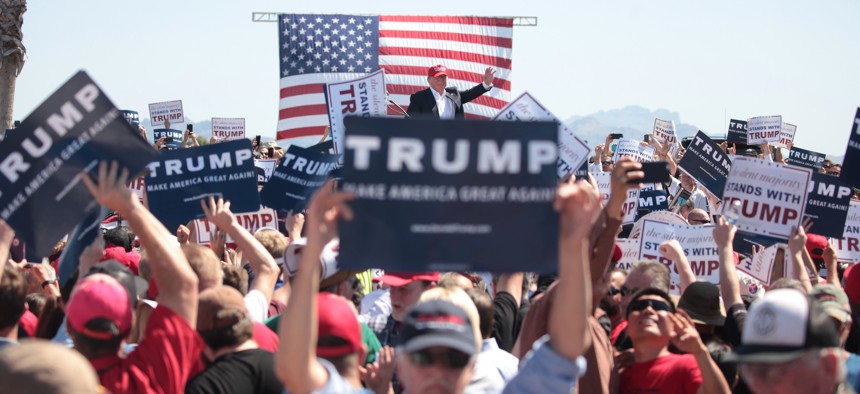
Flickr user Gage Skidmore
Culture Is Replacing Class as the Key Political Divide
On both sides of the Atlantic—in the United Kingdom and the United States—political parties are realigning and voters’ allegiances are shifting.
When United Kingdom voters last week narrowly approved a referendum to leave the European Union, they underscored again how an era of unrelenting economic and demographic change is shifting the axis of politics across much of the industrialized world from class to culture.
Contrary to much initial speculation, the victory for the U.K. leave campaign didn’t point toward victory in the U.S. presidential election for Donald Trump, who is voicing very similar arguments against globalization and immigration; The British results, in fact, underscored the obstacles facing his agenda of defensive nationalism in the vastly more diverse U.S. electorate.
But the Brexit referendum did crystallize deepening cultural fault lines in U.K. politics that are also likely to shape the contest between Trump and Hillary Clinton. In that way, the results prefigure both a continuing long-term realignment in the electoral base of each American party—and a possible near-term reshuffle of the tipping-point states in presidential politics.
Both geographically and demographically, the British referendum split the U.K. along lines familiar in America. An extensive election-day survey by Lord Michael Ashcroft, a British pollster, found that the leave campaign carried over three-fifths of those without four-year college degrees, a comparable number of seniors, and a narrow majority of all whites. Election results showed the leave campaign amassing big margins outside of major cities. The campaign to remain won over two-thirds of non-whites, about three-fifths of college graduates, and big majorities among younger and urban voters. In London, which recently elected one of the western world’s first Muslim mayors, 60 percent voted to stay.
All of this replicates American patterns. Democrats now rely on an urbanized coalition of Millennials, minorities, and socially liberal college-educated and single whites (especially women). Republicans thrive among older, non-college educated and religiously devout whites, especially outside of major cities. In 2012, President Obama carried less than one-fourth of America’s counties; he won fewer counties than any presidential winner since at least 1920. But because Obama so dominated the nation’s population centers, he triumphed by 5 million votes.
Not only was the distribution of the British vote familiar, so was the motivation. Ashcroft’s poll found that leave voters were characterized by pessimism about the next generation’s economic prospects, and deep hostility to immigration, multiculturalism, and the changing role of women. Fully 80 percent of leave voters said immigration negatively affected the U.K. That exactly equaled the percentage of Trump supporters who called immigration more of a burden than benefit in a major new US national poll. Stanley B. Greenberg, a long-time pollster both for U.S. Democrats and the U.K. Labor Party, says a post-referendum survey he conducted for the British Trades Union Congress found that among those who voted to leave, “the biggest rationale, and the strongest arguments, were opposition to immigration.”
In these ways, the British vote showed the power of the Trump-like anti-immigration, anti-globalization argument for white, older, non-urban and non-college-educated voters who feel marginalized by economic and cultural change. The key difference is those voters represent much less of the U.S. electorate. In particular, while whites comprised about 90 percent of British voters, they will likely cast only around 70 percent of American ballots. In the U.K., Ashcroft found 53 percent of whites voted to leave; because Trump faces so much opposition from minorities, if he wins the same percentage of whites, he will lose in a landslide. He will likely need well over 60 percent of whites to win.
If anything, the resistance to the leave campaign’s nativism from college-educated and urban U.K. whites underscores the headwinds Trump will face reaching that number. Since 2000, every Democratic presidential candidate has run better among college-educated than non-college-educated whites. But even so, in modern polling tracing back to 1952, no Democratic presidential candidate has ever carried most of those college-educated whites. Yet the last five national surveys have shown Clinton leading Trump with them. Greenberg predicts that as the GOP is tugged more toward the resistance to immigration (and diversity more broadly) of its culturally conservative blue-collar wing, more college-educated voters will defect, perhaps lastingly. “They drove their college-educated voters out by the nature of this primary,” he said.
Revolving around these cultural differences, the Trump-Clinton contest seems certain to accelerate the two parties’ long-term re-sorting into a cosmopolitan, urban-centered Democratic coalition comfortable with demographic and cultural changes and a primarily non-urban traditionalist Republican coalition mostly resistant to them. That ongoing shift’s most immediate 2016 effect may be to reorder the states at the tipping point of U.S. elections.
Since 1992, Democrats have run better in older and heavily white working-class Rustbelt swing states like Michigan, Pennsylvania, Wisconsin, Ohio, and Iowa than younger and diverse Sunbelt swing states including Virginia, North Carolina, Florida, Colorado, and Nevada. (Over those six elections, Democrats have won those Rustbelt states a combined 27 times out of 30 chances and the Sunbelt battlegrounds only 13.) But many signs suggest that alignment may start to invert this year. With its big Hispanic population, Florida could be better terrain for Clinton than largely blue-collar Ohio or even Pennsylvania. And her campaign is intensely focused on North Carolina, which has voted Democratic only once since 1992—while Trump supporters almost universally agree that any plausible path to the White House runs through the Rust Belt states Democrats have dominated since then.
(Top image via Flickr user Gage Skidmore)
NEXT STORY: Play of the Day: Benghazi and Trey Gowdy







